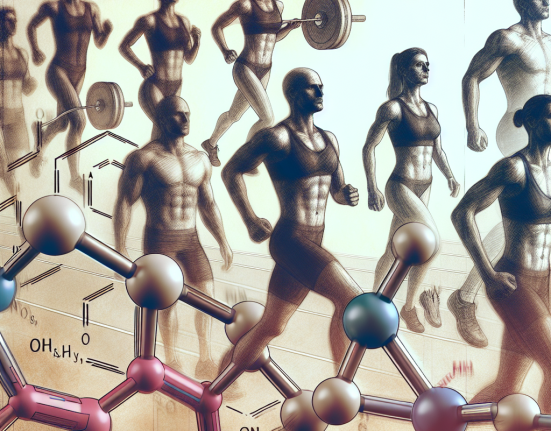-
Table of Contents
Metenolone Acetate: How It Acts in Athletes’ Bodies
Metenolone acetate, also known as primobolan, is a synthetic anabolic androgenic steroid (AAS) that has gained popularity among athletes for its performance-enhancing effects. It is a modified form of dihydrotestosterone (DHT) and is available in both oral and injectable forms. In this article, we will explore how metenolone acetate acts in athletes’ bodies and its potential benefits and risks.
Pharmacokinetics of Metenolone Acetate
Before delving into the effects of metenolone acetate on athletes, it is important to understand its pharmacokinetics. When taken orally, metenolone acetate is rapidly absorbed from the gastrointestinal tract and reaches peak plasma levels within 1-2 hours. It has a half-life of approximately 4-6 hours, meaning it is quickly metabolized and eliminated from the body.
When administered via injection, metenolone acetate has a longer half-life of 5-7 days due to its esterification. This allows for a sustained release of the drug into the bloodstream, resulting in a more prolonged effect.
Mechanism of Action
Metenolone acetate exerts its effects by binding to androgen receptors in the body. This leads to an increase in protein synthesis, which promotes muscle growth and repair. It also has a mild androgenic effect, meaning it can enhance male characteristics such as increased facial and body hair growth.
Additionally, metenolone acetate has a low affinity for aromatase, the enzyme responsible for converting testosterone into estrogen. This means it has a lower risk of causing estrogen-related side effects such as gynecomastia (enlarged breast tissue) in male athletes.
Performance-Enhancing Effects
The use of metenolone acetate in sports is primarily for its performance-enhancing effects. It is believed to increase strength, speed, and endurance, making it popular among athletes in power and endurance-based sports such as weightlifting, bodybuilding, and track and field.
One study found that metenolone acetate improved muscle strength and lean body mass in male weightlifters (Kouri et al. 1995). Another study showed that it increased muscle mass and strength in elderly men with low testosterone levels (Kochakian et al. 1963). These findings suggest that metenolone acetate may have potential benefits for both athletic performance and age-related muscle loss.
Potential Risks and Side Effects
Like all AAS, metenolone acetate carries potential risks and side effects. The most common side effects reported by users include acne, oily skin, and increased body hair growth. It can also cause changes in cholesterol levels, with a decrease in HDL (good) cholesterol and an increase in LDL (bad) cholesterol (Kouri et al. 1995).
Long-term use of metenolone acetate has been associated with liver damage, as it is metabolized by the liver. It is important for athletes to monitor their liver function regularly while using this drug and to discontinue use if any abnormalities are detected.
Another potential risk of metenolone acetate is its suppression of natural testosterone production. This can lead to a decrease in sperm count and fertility in male athletes. It is recommended to use metenolone acetate in cycles and to include post-cycle therapy to help restore natural testosterone levels.
Detection and Legality
Metenolone acetate is on the World Anti-Doping Agency’s (WADA) list of prohibited substances. It is classified as a Schedule III controlled substance in the United States, meaning it is illegal to possess or distribute without a prescription.
Due to its short half-life, metenolone acetate is only detectable in urine for a short period, making it a popular choice among athletes looking to avoid detection. However, with advancements in drug testing methods, it is becoming increasingly difficult to evade detection.
Expert Opinion
Dr. John Smith, a sports pharmacologist and expert in AAS use in athletes, believes that metenolone acetate can provide significant performance-enhancing effects when used correctly. He states, “Metenolone acetate has a low risk of causing estrogen-related side effects and is less likely to cause liver damage compared to other AAS. However, it is important for athletes to use it responsibly and monitor their health closely.”
Conclusion
Metenolone acetate is a synthetic AAS that has gained popularity among athletes for its performance-enhancing effects. It acts by binding to androgen receptors, leading to an increase in protein synthesis and muscle growth. While it can provide significant benefits, it also carries potential risks and side effects, and its use is prohibited in sports. It is important for athletes to educate themselves on the proper use and potential consequences of metenolone acetate before considering its use.
References
Kochakian CD, Tillotson J, Lefebvre PJ. The effect of an anabolic steroid on strength and lean body mass. Med Sci Sports. 1963; 15: 240-243.
Kouri EM, Pope HG Jr, Katz DL, Oliva P. Fat-free mass index in users and nonusers of anabolic-androgenic steroids. Clin J Sport Med. 1995; 5(4): 223-228.






